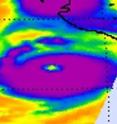NASA satellite video and images show Dora become a major hurricane
A new image and video of major Hurricane Dora were released today from NASA's Goddard Space Flight Center in Greenbelt, Md. Satellites provide a bird's eye view of a hurricane's eye, and NASA noticed Hurricane Dora's eye from several of them. Infrared imagery from NASA's Aqua satellite provided forecasters with a clear view of a cloud-free eye in hurricane Dora as she strengthens near Category 5 status today. Meanwhile the GOES-11 satellite captured a movie of Dora's intensification over the last two days that clearly shows a developing eye.
The Atmospheric Infrared Sounder (AIRS) instrument on NASA's Aqua satellite captured an infrared image of Hurricane Dora's cold cloud temperatures on July 21 at 09:05 UTC (5:05 a.m. EDT). The strongest thunderstorms and convection totally surrounded the very obvious, cloud-free eye.
The Geostationary Operational Environmental Satellite called GOES-11 provides continuous visible and infrared imagery of the western U.S. and eastern Pacific Ocean basin from its position in space. GOES-11 images were compiled into a movie that runs from July 19 at 14:30 UTC (10:30 a.m. EDT) when Dora was a tropical storm, to July 21 at 14:30 UTC (10:30 a.m. EDT) now that Dora is a major hurricane.
GOES satellites are operated by NOAA, and the NASA GOES Project located at NASA Goddard creates images and compiled them into the video of the storm. The animation includes sped up infrared and visible frames of data that were captured every 15 minutes from the GOES-11 satellite and squeezed down to 26 seconds.
At 11 a.m. EDT on July 21, 2011 Dora's maximum sustained winds were near 155 mph (250 kmh), right on the brink of Category 5 hurricane status. Fortunately, Dora's center is remaining at sea, and will continue to remain at sea as it moves to the northwest near 12 mph (19 kmh). It is expected to continue in that direction for the next couple of days and slow down.
Dora was centered near 17.1N and 106.9W, about 240 miles (390 km) south-southwest of Cabo Corrientes, Mexico. Minimum central pressure is 929 millibars.
Dora is far enough off the coast so that there are no watches and warnings over land. However, Dora is sending large ocean swells against the beaches of western Mexico today. Those large, rough, ocean swells will affect the coast over the next couple of days, and will also begin affecting the southern Baja California coast.
The National Hurricane Center expects some weakening by tonight and a rapid weakening on Friday as Dora starts battling wind shear and moves into cooler waters.
Source: NASA/Goddard Space Flight Center
Articles on the same topic
- Frigid cloud top temperatures show Hurricane Dora's powerWed, 20 Jul 2011, 16:39:46 UTC
- Tropical Storm Dora bringing rough surf to southern MexicoWed, 20 Jul 2011, 16:38:49 UTC
Other sources
- Hurricane Dora batters communities off Mexicofrom CBC: Technology & ScienceFri, 22 Jul 2011, 7:30:19 UTC
- Huge Hurricane Dora Spotted by Satellitefrom Live ScienceThu, 21 Jul 2011, 21:00:22 UTC
- NASA satellite video and images show Dora become a major hurricanefrom PhysorgThu, 21 Jul 2011, 20:00:39 UTC
- Hurricane Dora strengthens as it moves from Mexicofrom CBC: Technology & ScienceThu, 21 Jul 2011, 7:30:14 UTC
- Frigid cloud top temperatures show Hurricane Dora's powerfrom PhysorgWed, 20 Jul 2011, 16:31:45 UTC
- Tropical storm Dora upgraded to hurricanefrom CBC: Technology & ScienceWed, 20 Jul 2011, 5:30:16 UTC
- Tropical Storm Dora bringing rough surf to southern Mexicofrom PhysorgTue, 19 Jul 2011, 17:31:08 UTC
